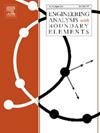A theoretical proof of superiority of Smoothed Finite Element Method over the conventional FEM
IF 4.2
2区 工程技术
Q1 ENGINEERING, MULTIDISCIPLINARY
Engineering Analysis with Boundary Elements
Pub Date : 2024-11-02
DOI:10.1016/j.enganabound.2024.106007
引用次数: 0
Abstract
Numerous simulations have shown that Smoothed Finite Element Method (S-FEM) performs better than the standard FEM. However, there is lack of rigorous mathematical proof on such a claim. This task is challenging since there are so many variants of S-FEM and the standard FEM theory in Sobolev space does not work for S-FEM because of the Smoothed Gradient. Another long-standing open problem is to establish the theory of FEM parameter. The FEM could be the most flexible and fastest S-FEM variant. Its energy is even exact if the parameter is fine-tuned. So this problem is practical and interesting. By the help of nonlinear essential boundary (geometry), Weyl inequalities (algebra) and matrix differentiation (analysis), this parameter problem leads us to estimate the eigenvalue-gap and energy-gap between S-FEM and FEM. Consequently, we provide a definite answer to the long-standing S-FEM superiority problem in a unified framework. The essential boundary, eigenvalue and energy are linked together by four new necessary and sufficient conditions which are simple, practical and beyond our expectations. The standard S-FEM source code can be reused so it is convenient to numerically implement. Finally, the cantilever and infinite plate with a circular hole are simulated to verify the proof.
平滑有限元法优于传统有限元法的理论证明
大量模拟结果表明,平滑有限元法(S-FEM)的性能优于标准有限元法。然而,这种说法缺乏严格的数学证明。这项任务极具挑战性,因为 S-FEM 有许多变体,而且由于平滑梯度的存在,Sobolev 空间中的标准有限元理论对 S-FEM 不适用。另一个长期悬而未决的问题是建立 αFEM 参数理论。αFEM 可能是最灵活、最快的 S-FEM 变体。如果对参数进行微调,它的能量甚至是精确的。因此,这个问题既实用又有趣。借助非线性基本边界(几何)、韦尔不等式(代数)和矩阵微分(分析),这个参数问题引导我们估计 S-FEM 和 FEM 之间的特征值差距和能量差距。因此,我们在一个统一的框架内为长期存在的 S-FEM 优越性问题提供了一个明确的答案。四个新的必要条件和充分条件将基本边界、特征值和能量联系在一起,这些条件简单实用,超出了我们的预期。标准 S-FEM 源代码可以重复使用,因此便于数值实现。最后,对悬臂和带圆孔的无限板进行了仿真,以验证证明。
本文章由计算机程序翻译,如有差异,请以英文原文为准。
求助全文
约1分钟内获得全文
求助全文
来源期刊

Engineering Analysis with Boundary Elements
工程技术-工程:综合
CiteScore
5.50
自引率
18.20%
发文量
368
审稿时长
56 days
期刊介绍:
This journal is specifically dedicated to the dissemination of the latest developments of new engineering analysis techniques using boundary elements and other mesh reduction methods.
Boundary element (BEM) and mesh reduction methods (MRM) are very active areas of research with the techniques being applied to solve increasingly complex problems. The journal stresses the importance of these applications as well as their computational aspects, reliability and robustness.
The main criteria for publication will be the originality of the work being reported, its potential usefulness and applications of the methods to new fields.
In addition to regular issues, the journal publishes a series of special issues dealing with specific areas of current research.
The journal has, for many years, provided a channel of communication between academics and industrial researchers working in mesh reduction methods
Fields Covered:
• Boundary Element Methods (BEM)
• Mesh Reduction Methods (MRM)
• Meshless Methods
• Integral Equations
• Applications of BEM/MRM in Engineering
• Numerical Methods related to BEM/MRM
• Computational Techniques
• Combination of Different Methods
• Advanced Formulations.
 求助内容:
求助内容: 应助结果提醒方式:
应助结果提醒方式:


